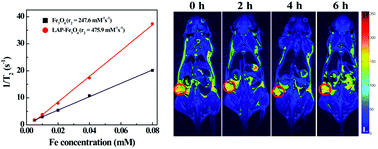LAPONITE®-stabilized iron oxide nanoparticles for in vivo MR imaging of tumors†
Abstract
We report the synthesis, characterization and utilization of LAPONITE®-stabilized magnetic iron oxide nanoparticles (LAP-Fe3O4 NPs) as a high performance contrast agent for in vivo magnetic resonance (MR) detection of tumors. In this study, Fe3O4 NPs were synthesized by a facile controlled coprecipitation route in LAP solution, and the formed LAP-Fe3O4 NPs have great colloidal stability and about 2-fold increase of T2 relaxivity than Fe3O4 NPs (from 247.6 mM−1 s−1 to 475.9 mM−1 s−1). Moreover, cytotoxicity assay and cell morphology observation demonstrate that LAP-Fe3O4 NPs display good biocompatibility in the given Fe concentration range, and in vivo biodistribution results prove that NPs can be metabolized and cleared out of the body. Most importantly, LAP-Fe3O4 NPs can not only be used as a contrast agent for MR imaging of cancer cells in vitro due to the effective uptake by tumor cells, but also significantly enhance the contrast of a xenografted tumor model. Therefore, the developed LAP-based Fe3O4 NPs with good colloidal stability and exceptionally high transverse relaxivity may have tremendous potential in MR imaging applications.


 Please wait while we load your content...
Please wait while we load your content...